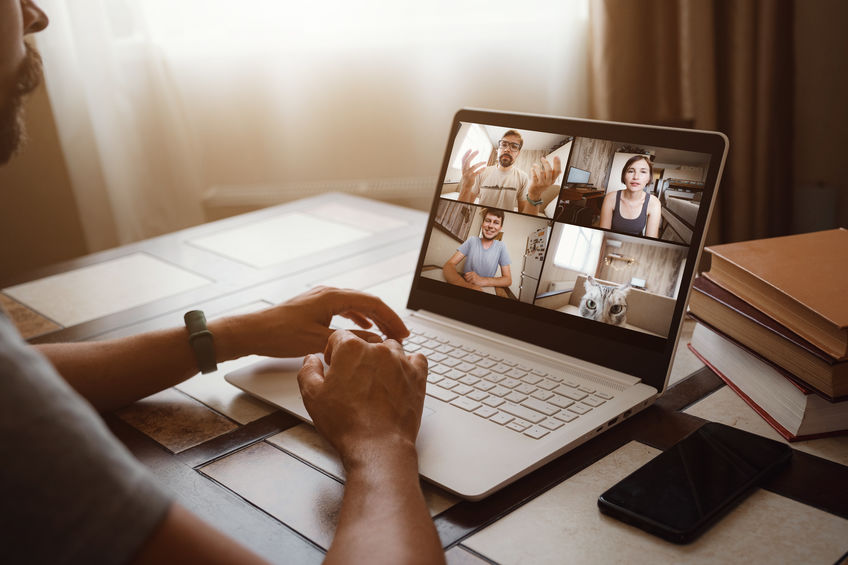Zoom meetings and health are related and not in a positive way. For the last year, many of us have sat in an endless series of Zoom conferences. While it is a practical solution to staying connected without going into the office, it is taking a toll on our health.
Even before Covid, most Americans spent 12 out of their 16 waking hours sitting. But now that back-to-back Zoom meetings have become commonplace, we are sitting more than ever. Many of my clients complain of back pain and I think a lot of it is related to sedentary behavior.
This article alerted me to a new term: dead butt syndrome. I found the term amusing and intriguing, so I had to read this article in Health Magazine.
Zoom Meetings and Health
Zoom meetings and health are inversely related and dead butt syndrome is one more reason you shouldn’t sit all day. Yep, it’s a real condition in which a gluteal muscle stops firing correctly. Here’s how to avoid it.
It’s no secret that sitting for long stretches isn’t great for your body. Research has linked it to heart disease, obesity, diabetes, even cancer. But there’s another health risk from sitting all day that most people don’t know about: gluteal amnesia, or dead butt syndrome.
It almost sounds like a joke, but it’s not uncommon, says Andrew Bang, a chiropractor at the Cleveland Clinic’s Wellness Institute: “I see the injury all the time in varying degrees.”
What is Dead Butt Syndrome?
Dead butt syndrome develops when the gluteus medius—one of the three main muscles in the booty—stops firing correctly. That can happen if you spend too much time parked in a chair, explains Kristen Schuyten, a physical therapist at Michigan Medicine. “But it can also occur in very active individuals who just don’t engage the glute muscles enough,” she adds.
Since the gluteus medius normally helps stabilize the pelvis, gluteal amnesia can lead to lower back pain and hip pain, as well as knee and ankle issues, as the body tries to compensate for the imbalance.
Dead butt syndrome has to do with reciprocal inhibition—the process that describes the give-and-take relationship between muscles on either side of a joint. “In general, when one muscle contracts, a nerve signal is sent to its opposing muscle to relax,” says Bang.
When you spend hours on end in a seated position, your hip flexors are contracting while your glutes rest. “Over time, we’re basically training our glutes to be weak,” Bang says.
The same type of muscle imbalance can happen in highly active people who have very strong quads or hamstrings. Bang has even seen marathon runners develop dead butt syndrome
How do you know if you have gluteal amnesia?
One way practitioners pronounce a butt dead is with the Trendelenburg test, a physical exam in which a person lifts one leg in front of them while standing. “If the pelvis dips down on the side of the body where the leg is lifted, that indicates weakness in the gluteus medius on the opposite side,” says Bang.
The curve in a person’s back can also suggest gluteal amnesia. While the lumbar spine (or lower back) should naturally form an S shape, more extreme curvature may signal that the hip flexors are so tight they’re pulling the spine forward, says Bang.
What can you do to avoid dead butt syndrome?
• Try to take frequent breaks from your chair throughout the day. Get up and walk around, or do some stretches at your desk. Schuyten recommends setting hourly reminders on your phone, to prompt you to squeeze your butt muscles at regular intervals.
• And when you work out, don’t forget to target that booty. Along with squats and bridges, lying-down leg lifts are a good move to add to your routine, says Bang. “Start on your left side with your right leg lifted and the big toe pointing toward the floor as you lift,” he says. “This angle isolates the gluteus medius and minimus muscles the most, so you’ll feel it within 10 to 15 lifts of the leg.” Add a band or ankle weight for extra resistance.
• Above all, the best way to avoid gluteal amnesia is to mix up your daily routine, says Bang. Sit on an exercise ball for part of the day. Spend some time standing up, working at a high countertop. “Whatever you do, just don’t allow your body to get into a repetitive cycle,” he says.
Ways to combat dead butt syndrome
• Get up and move at least 5 minutes per hour. The movement doesn’t need to be vigorous or lengthy, says Jo; some jumping jacks or squats will do the trick. It’s about consistency. “The more we move throughout the day, the better it is for your health,” says Jo. One easy fix? Instead of sitting at your desk, start pacing while taking your calls.
• Practice proper posture while sitting. That means your elbows should be bent at a 90-degree angle, your hips should be at a 90-degree angle, and your knees should be at a 90-degree angle. “Keep both feet level on the floor versus sitting cross-legged or with one hip higher than the other,” says Fitzgerald—that’ll keep your hips properly aligned.
• Stretch every day, unrelated to your workout. “Target the front of your body—your chest, shoulders, and hips—which gets chronically shortened while sitting,” says Jo. Do these two moves for at least 2 minutes (or 1 minute per leg): the Half-Kneeling Hip Stretch and the Marching Glute Bridge. Incorporate these into your day, and your butt will be good to go.
Click here to read more about Zoom meetings and health.






